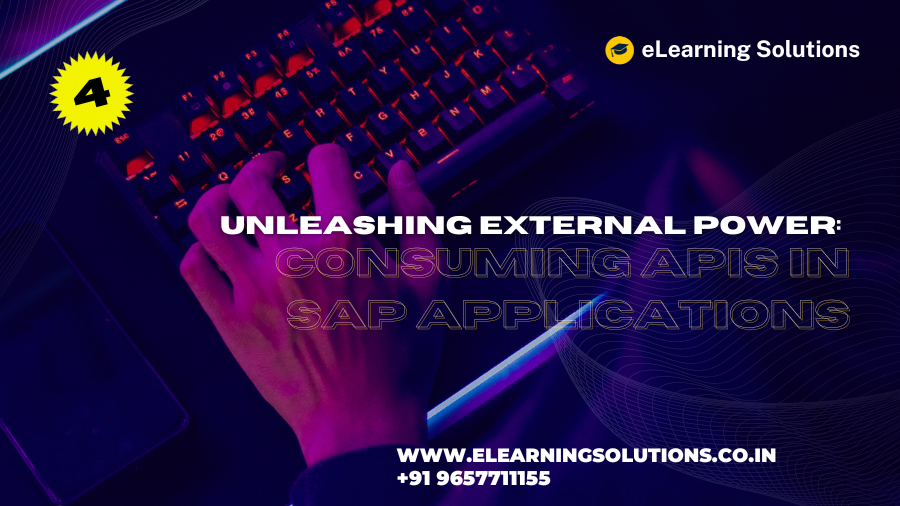External Power: Consuming APIs in SAP Applications (Part 4)
The previous parts of this blog series have demystified APIs in SAP, explored their various types, and unveiled their potential benefits. Now, it’s time to delve into the practical aspects – consuming third-party APIs in SAP applications. This empowers you to integrate with external systems, unlock a world of data, and orchestrate complex workflows.
Bridging the Gap: Tools and Libraries for API Consumption
Consuming APIs in SAP applications doesn’t require reinventing the wheel. Here are some powerful tools and libraries that streamline the process:
- ABAP Connectivity Framework (ICF): This built-in framework within SAP NetWeaver provides classes and functionalities specifically designed for sending HTTP requests and receiving responses. Ideal for developers familiar with ABAP programming.
- SAP Cloud Platform – Integration Services: For cloud-based integrations, SAP Cloud Platform offers a robust suite of tools. Leverage services like “API Business Hub” to discover and manage APIs, and “SAP Cloud Connector” to securely connect to on-premise systems.
- External Libraries: The world of open-source libraries offers a wealth of options for API consumption in SAP. Popular choices include libraries like “RestEasy” (Java) or “Requests” (Python), which can be integrated with SAP Cloud Platform applications.
Crafting the Code: Sending Requests and Handling Responses
Once you’ve chosen your tools, here’s a basic structure for consuming an API within your SAP application:
- API Discovery and Definition: Carefully analyze the API documentation to understand its endpoints, authentication methods, request parameters, and response formats.
- Building the Request: Use the chosen library or framework to construct the HTTP request message. Specify the API endpoint URL, HTTP method (GET, POST, etc.), headers (including authentication tokens if required), and any request body data.
- Sending the Request: Trigger the request using the appropriate library functions, initiating communication with the external API.
- Handling the Response: Parse the response received from the API. This might involve converting JSON or XML data into usable structures within your SAP application.
- Processing the Data: Extract the relevant information from the API response and utilize it within your application logic. This could involve updating SAP data models, triggering workflows, or displaying data to users.
Remember: Security is paramount! Always adhere to best practices for secure API access, such as using HTTPS and implementing proper authentication mechanisms.
Building Integration Symphonies: Combining Data from Multiple Sources
The true power of API consumption lies in its ability to orchestrate complex integrations. Here’s how you can combine data from various APIs and internal SAP data sources:
- Data Mapping and Transformation: Utilize tools within your chosen integration platform (like SAP Cloud Platform Integration Services) to map data from different sources into a unified format, ensuring seamless integration within your SAP application logic.
- Orchestration Workflows: Design workflows that call upon multiple APIs in a specific sequence, potentially combining data from internal SAP tables and external APIs to achieve a desired outcome.
- Error Handling and Exception Management: Robust error handling mechanisms are crucial. Implement logic to handle potential API failures, timeouts, or unexpected responses, ensuring the overall integration process remains resilient.
Beyond Simple Requests: Exploring Advanced Integration Patterns
For truly sophisticated integrations, consider these advanced patterns:
- Message Queues: Implement message queues as a buffer between your SAP application and external APIs. This decouples the systems, allowing them to communicate asynchronously and improving overall scalability.
- Real-time Event Processing: For scenarios requiring immediate action based on external events, leverage real-time event processing tools. These tools can react to data changes in real-time, triggering workflows or updates within your SAP system.
By mastering these techniques, you can transform your SAP applications into powerful integration hubs, seamlessly exchanging data with external systems and unlocking a new level of functionality and efficiency within your organization.
Conclusion: The API Advantage – A World of Opportunity Awaits
Consuming APIs in SAP applications opens a gateway to a world of possibilities. By leveraging the tools, libraries, and integration patterns discussed in this blog, you can craft robust and scalable integrations that empower your SAP applications to interact with external systems, exchange data seamlessly, and automate complex workflows. Embrace the power of API consumption and transform your SAP landscape into a truly connected and intelligent ecosystem.
This concludes our in-depth exploration of APIs in SAP applications. We hope this series has equipped you with the knowledge and tools to embark on your API integration journey. Stay tuned for further explorations into the ever-evolving world of SAP and its integration capabilities!



 WhatsApp us
WhatsApp us